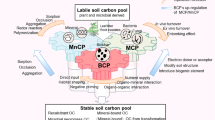Abstract
Flows of biomass and respiratory carbon were studied in a series of propylene-oxide sterilized soil microcosms. One-half of the microcosms received three pulsed additions of 200 ppm glucose-carbon to mimic rhizosphere carbon inputs. Biotic variables were: bacteria (Pseudomonas) alone, or amoebae (Acanthamoeba) and nematodes (Mesodiplogaster) singly, or both combined in the presence of bacteria.
Over the 24-day experiment, respiration was significantly higher in the microcosms containing the bacterial grazers. Biomass accumulation by amoebae was significantly higher than that by nematodes. The nematodes respired up to 30-fold more CO2 per unit biomass than did amoebae. Similar amounts of carbon flowed into both respiratory and biomass carbon in microcosms with fauna, compared with the bacteria-alone microcosms. However, partitioning of available carbon by the microfauna varied considerably, with little biomass production and relatively more CO2-C produced in the nematode-containing microcosms. The amoebae, in contrast, allocated more carbon to tissue production (about 40% assimilation efficiency) and correspondingly less to CO2.
Similar content being viewed by others
References
Anderson, R. V., E. T. Elliott, J. F. McClellan, D. C. Coleman, C. V. Cole, and H. W. Hunt: Trophic interactions in soils as they affect energy and nutrient dynamics. III. Biotic interactions of bacteria, amoebae, and nematodes: Microb. Ecol. (this volume)
Boucher, G., and S. Chamroux: Bacteria and meiofauna in an experimental sand ecosystem. I. Material and preliminary results. J. Exp. Mar. Biol. Ecol.24, 237–249 (1976)
Clark, F. E.: Ecological associations among soil microorganisms. In: Soil Biology: Reviews of Research, pp. 125–161. UNESCO, Paris (1969)
Cole, C. V., E. T. Elliott, H. W. Hunt, D. C. Coleman and M. K. Campion: Trophic interactions in soils as they affect energy and nutrient dynamics. V. Phosphorus transformations. Microb. Ecol. (this volume)
Coleman, D. C.: Compartmental analysis of total soil respiration. Oikos24, 361–366 (1973)
Danforth, W. F.: Respiratory metabolism. In: T. Chen (Ed.): Research in Protozoology, Vol. 1, pp. 201–306. Pergamon Press, New York (1967)
Dittmer, J. C., and M. A. Wells: Quantitative and qualitative analysis of lipids and lipid components. In: J. M. Lowenstein (Ed.): Methods of Enzymology: Vol. 14, Lipids, pp. 482–523. Academic Press, New York (1969)
Fenchel, T. M., and B. B. Jorgenson: Detritus food chains of aquatic ecosystems: the role of bacteria. In: M. Alexander (Ed.): Advances in Microbial Ecology, Vol. 1, pp. 1–58. Plenum Press, New York (1977)
Hu, L., C. T. Youngberg, and C. M. Gilmour: Readily oxidizable carbon: an index of decomposition and humification of forest litter. Soil Sci. Soc. Am. Proc.36, 959–961 (1972)
Klekowski, R. Z., L. Wasilewska, and E. Paplinska: Oxygen consumption by soil-inhabiting nematodes. Nematologica18, 391–403 (1972)
Macfadyen, A.: The contribution of the microfauna to total soil metabolism. In: J. Doeksen and J. van der Drift (Eds.): Soil Organisms, pp. 3–17. North-Holland, Amsterdam (1964)
Marchant, R., and W. L. Nicholas: An energy budget for the free-living nematodePelodera (Rhabditidae). Oecologia16, 237–252 (1974)
McGill, W. B., E. A. Paul, J. A. Shields, and W. E. Lowe: Turnover of microbial populations and their metabolites in soils. Bull. Ecol. Res. Comm. (Stockh.)17, 293–301 (1973)
Nicholas, W. L., and S. Viswanathan: A study of the nutrition ofCaenorhabditis briggsae (Rhabditidae) fed on14C and32P-labelled bacteria. Nematologica21, 385–400 (1975)
Shields, J. A., W. E. Lowe, E. A. Paul, and D. Parkinson: Turnover of microbial tissue in soil under field conditions. Soil Biol. Biochem.5, 753–764 (1973)
Sollins, P. L., D. C. Coleman, B. S. Ausmus, and K. Cromack: A new ecology? A view from within. Ecology57, 1101–1103 (1976)
Stotzky, G., and A. G. Norman: Factors limiting microbial activities in soil. I. The level of substrate, nitrogen, and phosphorus. Arch. Mikrobiol.40, 341–369 (1961)
Waksman, S. A. and R. L. Starkey: Microbiological analysis of soil as an index of soil fertility. VII. Carbon dioxide evolution. Soil Sci.17, 141–161 (1924)
Author information
Authors and Affiliations
Rights and permissions
About this article
Cite this article
Coleman, D.C., Anderson, R.V., Cole, C.V. et al. Trophic interactions in soils as they affect energy and nutrient dynamics. IV. Flows of metabolic and biomass carbon. Microb Ecol 4, 373–380 (1977). https://doi.org/10.1007/BF02013280
Issue Date:
DOI: https://doi.org/10.1007/BF02013280




